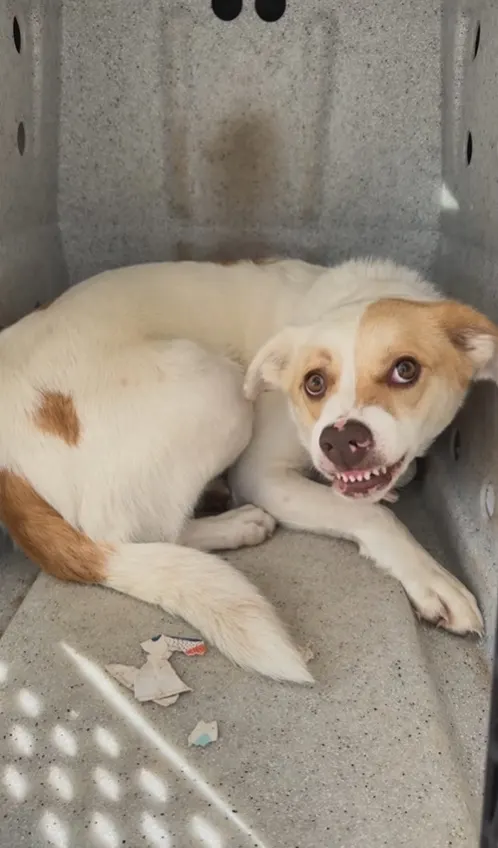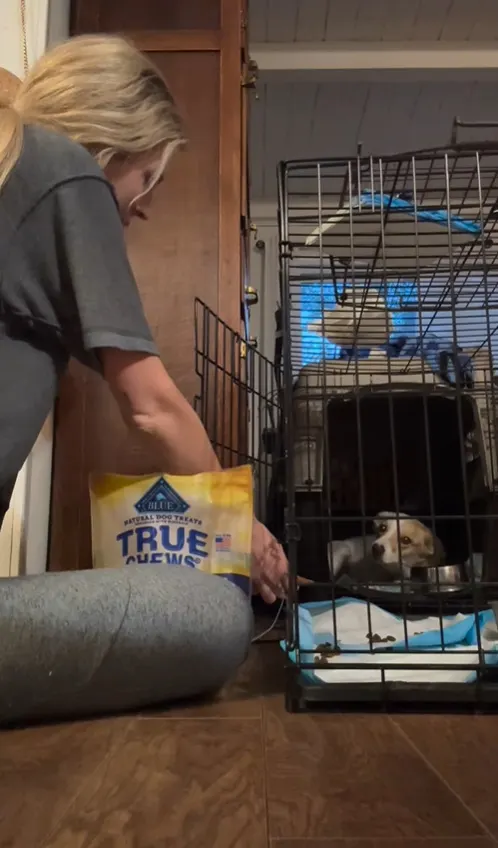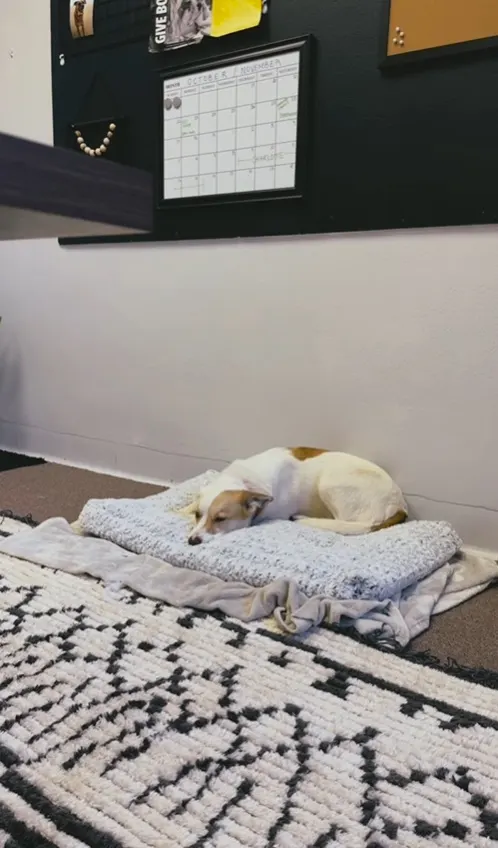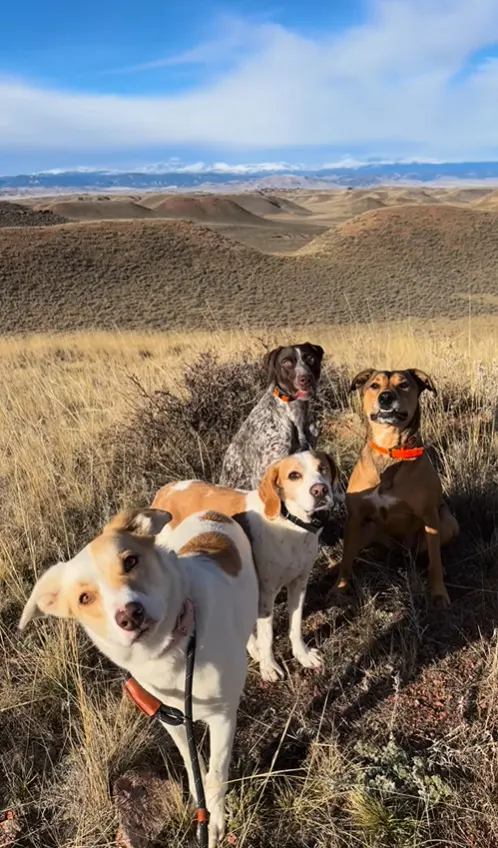A human and dog relationship is one of the most special and treasured bonds we have, and it’s often understated.
While I can understand that not every person has to be a dog lover, I expect all people to show at least some sort of respect to them.
The reality is different, unfortunately, and it’s hard thinking about how often they are mistreated without any of it being their fault.
In this story, we will talk about a sweet rescue dog who was so frightened of humans that she outright refused and growled at anyone who got close to her.
A Very Troubled Dog

When Mia was first saved by rescuers from Onalaska Farm Sanctuary in Washington, she had been dealing with a lot of trauma from her past encounters and was terrified of people.
Anytime anyone tried to approach her, she would just growl and start barking. She didn’t have any faith in anybody.
I just can’t even begin to imagine what Mia had to go through with other people in order to react in such a way.
The people who saved her knew it would be a challenging task to help her regain her trust in humanity, but one of the rescuers, Angela, decided to accept this challenge.

She took Mia to her home in Washington, and one of the first things on her mind was to just let her adapt slowly to the new environment and get more comfortable there.
Angela told The Dodo: “The first few days, when I would come in and out of the room, she would kind of run back into her kennel and peer out at me.”
Mia was also very hesitant to accept Angela’s kindness, and she would not let her pet her for the first few days she was there.
Mia Has Regained Her Trust

In order to help her get out of her shell more often, she would leave food out so Mia would have to get out of the kennel and eat it.
This naturally helped her get more comfortable in the new environment, but she still needed that one extra push that would help her relax even more.
After a while, she would even let Angela pet her. She said: “I started to kind of pet her a little bit through the bars of the kennel. That’s when I think we had a breakthrough.”
Mia finally started believing that her rescuer only wanted what was best for her, and she let her guard down around her.
Soon enough, though, she would even come out of her kennel and start walking around the house. This was an even bigger milestone.

She had completely melted in Angela’s arms. It was almost like she was a completely different dog at this point.
Angela said: “Could not believe this dog who’s been trying to snarl and snap at me through the kennel is now rubbing her head all over me.”
She became such a loving and sweet dog in such a short time. Angela is so happy to have had the opportunity to help her recover from her trauma.
If this story can be interpreted in some way, it’s that dogs are different from us, and they will always give us another chance if we treat them with kindness and love.
If you’ve noticed your furry companion shedding more than usual, you might be wondering why your dog is losing hair. As a seasoned dog trainer, I’ve encountered this concern many times among pet owners. It can be concerning to see your pup’s coat thinning or bald patches appearing, but fret not, there are various reasons why this might be happening.
From dietary issues to skin infections, the causes of hair loss in dogs can be as diverse as the breeds themselves. Understanding the underlying factors behind your dog’s shedding is crucial in ensuring their health and well-being. In this article, we’ll take a closer look at some common reasons why your dog may be losing hair, helping you navigate this hairy situation with ease.
Understanding Canine Hair Loss
Common Reasons for Hair Loss in Dogs
Hair loss in dogs can be caused by a variety of factors, with some of the common reasons including:
- Allergies: Dogs can be allergic to various things like food, pollen, or even fleas, leading to excessive itching and hair loss.
- Parasites: Infestations of parasites such as mites, fleas, and ticks can irritate your dog’s skin, resulting in hair loss.
- Skin Infections: Bacterial or fungal infections can cause hair loss in dogs. These infections often lead to redness, itching, and flaky skin.
- Nutritional Deficiencies: Inadequate nutrition can impact your dog’s coat health, leading to hair loss. Essential nutrients like vitamins, minerals, and proteins are crucial for a healthy coat.
When to Be Concerned About Your Dog’s Hair Loss
While some shedding is normal for dogs, excessive hair loss could indicate a more serious issue. You should be concerned about your dog’s hair loss if you notice:
- Bald patches: If your dog is developing bald spots or patches of skin without any hair, it could be a sign of an underlying problem.
- Persistent scratching: Constant scratching or licking can indicate irritation, allergies, or parasites causing hair loss.
- Changes in skin: Any redness, flakiness, or sores on your dog’s skin along with hair loss should be addressed by a veterinarian.
- Behavioral changes: If you notice your dog becoming more lethargic, agitated, or uncomfortable along with hair loss, it’s essential to seek professional advice.
Monitoring your dog’s coat and skin health regularly can help you identify any issues early and ensure your furry friend stays healthy and happy.
Medical Conditions That Cause Hair Loss in Dogs
Hormonal Imbalances and Hair Loss
Hormonal imbalances can trigger hair loss in dogs. Issues with thyroid hormones or imbalances in sex hormones like testosterone can lead to excessive shedding. The disruption in hormone levels can affect the hair growth cycle, causing hair loss in patches or overall thinning.
Skin Infections and Parasites
Skin infections and parasites such as fleas, ticks, and mites can cause hair loss in dogs. These pests irritate the skin, leading to scratching and chewing, which damages the hair follicles. Infections like ringworm can also contribute to hair loss if left untreated, making it essential to address any skin issues promptly.
Genetic and Breed-Specific Causes
Certain genetic factors and breed-specific characteristics can contribute to hair loss in dogs. Breeds prone to alopecia or hairless breeds are genetically predisposed to hair loss. Understanding your dog’s breed characteristics and potential genetic predispositions can help you identify and manage hair loss effectively.
Nutritional Factors Contributing to Hair Loss
Essential Nutrients for a Healthy Coat
To maintain a healthy coat for your furry friend, ensure they’re getting the essential nutrients they need. Proteins, omega-3 fatty acids, vitamins A and E, and biotin play key roles in promoting hair growth and strength. Without these nutrients, your dog’s coat may become dull and prone to shedding.
The Impact of Diet on Your Dog’s Skin and Hair
Your dog’s diet directly affects the condition of their skin and hair. A balanced diet rich in high-quality proteins, healthy fats, and vitamins is essential for a shiny coat and overall skin health. Poor nutrition can lead to dry, flaky skin and brittle hair, resulting in hair loss. Ensure your dog’s diet meets their nutritional needs to support healthy skin and a luscious coat.
Impact of Grooming and Environmental Factors
Best Grooming Practices for Preventing Hair Loss
To help prevent hair loss in your furry friend, regular grooming is key. Brushing your dog’s coat not only removes loose fur but also stimulates blood circulation to the skin, promoting a healthy coat. Aim to brush your dog a few times a week, depending on the breed and length of their fur. Additionally, bathing your dog with a gentle shampoo suitable for their skin type can help maintain a clean and healthy coat, reducing the risk of hair loss.
Environmental Allergens and Irritants
Environmental factors can also play a role in your dog’s hair loss. Allergens like pollen, dust, and mold can irritate your dog’s skin, leading to excessive scratching and hair loss. To minimize the impact of environmental allergens, try to keep your dog’s living area clean, vacuum frequently, wash their bedding regularly, and consider using air purifiers to reduce airborne irritants. If you suspect your dog has allergies, consult your veterinarian for appropriate treatment options.
Remember, a healthy and shiny coat not only enhances your dog’s appearance but also indicates their overall well-being. By incorporating proper grooming practices and addressing environmental factors, you can help keep your furry companion’s coat looking lustrous and minimize hair loss.
Behavioral Causes of Hair Loss
Stress-Related Hair Loss in Dogs
Stress can manifest in various ways in dogs, including hair loss. When dogs experience stress due to changes in their environment, routine, or interactions, it can lead to hair loss. They may lick or chew excessively on their fur, causing bald patches. If you notice your dog displaying unusual behaviors or signs of stress, such as pacing, panting, or hiding, it’s essential to address the underlying issues to prevent further hair loss.
Excessive Licking and Chewing
Excessive licking and chewing are common behavioral causes of hair loss in dogs. Dogs may engage in these behaviors due to allergies, skin irritations, boredom, or anxiety. Constant licking and chewing can damage the hair follicles and result in hair loss. It’s crucial to identify the root cause of your dog’s behavior and provide appropriate interventions, such as vet-recommended treatments, behavior modification, or environmental changes, to help prevent hair loss and promote a healthy coat.
Ensure your furry companion feels safe and secure in their environment to prevent stress-related hair loss. Address any behavioral concerns promptly to maintain a healthy coat for your beloved pet.
Diagnosing Canine Hair Loss
What to Expect at the Vet’s Office
When you bring your furry friend to the vet due to hair loss, the first step is a thorough examination. The vet will ask questions about your dog’s medical history, diet, and recent changes. Be prepared to provide details about the duration and pattern of hair loss, any accompanying symptoms like itchiness, and your pet’s grooming routine.
After discussing your dog’s history, the vet will conduct a physical exam to assess the skin and coat condition. They may perform diagnostic tests such as skin scrapings, fungal cultures, blood work, or biopsies to identify the underlying cause of the hair loss accurately. Based on the findings, further specialized tests or referrals to veterinary dermatologists may be recommended.
Treatment Options for Hair Loss
The treatment for canine hair loss depends on the diagnosis. It could range from topical treatments for skin infections or parasites to medications for hormonal imbalances. In cases of allergies, dietary changes or hypoallergenic diets may be suggested. For nutritional deficiencies, supplements can help promote coat health.
Your vet may recommend specific grooming practices tailored to your dog’s condition. These could include medicated shampoos, conditioners, or oils to improve skin and coat health. Regular follow-up appointments may be necessary to monitor progress and adjust the treatment plan as needed.
It’s essential to follow your vet’s recommendations diligently and be patient with the treatment process. With proper diagnosis and care, many cases of canine hair loss can be effectively managed, leading to a healthy and luscious coat for your beloved pet.
Preventive Measures and Home Care
Supplements and Topical Solutions
To support your dog’s coat health, ensuring they get essential nutrients is key. Consider adding supplements like fish oil for omega-3 fatty acids and vitamin E to their diet. These supplements can help improve skin health and promote a shiny coat. Additionally, using topical solutions like medicated shampoos or conditioners recommended by your vet can aid in managing skin conditions and reducing hair loss.
Creating a Hair-Friendly Environment at Home
Your home environment can play a significant role in your dog’s hair health. Regularly cleaning your home to reduce allergens can help minimize allergic reactions that may contribute to hair loss. Providing a comfortable spot for your dog to rest, away from stressors, can also help prevent stress-related hair loss. Moreover, ensuring your dog has a balanced diet, regular exercise, and proper grooming can all contribute to a healthy coat and reduce the risk of excessive hair loss.
Conclusion
So, there you have it – a rundown on why your furry friend might be shedding more than usual. From allergies to nutrition, hormones to grooming, there are various factors at play when it comes to your dog’s hair loss. Remember, keeping an eye on their skin and coat health, providing a balanced diet, and minimizing stress can all help in managing hair loss. Whether it’s adding supplements, adjusting their environment, or simply giving them some extra TLC, taking proactive steps can make a big difference. By staying informed and proactive, you can help your pup maintain a healthy, shiny coat and minimize excessive shedding.
Frequently Asked Questions
What are the common reasons for hair loss in dogs?
Hair loss in dogs can be caused by allergies, parasites, nutritional deficiencies, hormonal imbalances, skin infections, parasites, and genetic factors.
Why is nutrition important for preventing hair loss in dogs?
Nutrition plays a crucial role in preventing hair loss in dogs by providing essential nutrients like proteins, omega-3 fatty acids, and vitamins A and E.
How can grooming practices help prevent hair loss in dogs?
Regular grooming practices can help prevent hair loss in dogs by maintaining coat and skin health, reducing the risk of skin infections and improving overall hair quality.
What are some environmental factors that can contribute to hair loss in dogs?
Environmental factors like allergens in the environment can contribute to hair loss in dogs, making it essential to create a hair-friendly environment at home.
How can stress and behavioral causes impact hair loss in dogs?
Stress-related hair loss and excessive licking due to behavioral reasons can contribute to hair loss in dogs, emphasizing the importance of providing a stress-free environment.
What preventive measures can be taken to manage canine hair loss at home?
Managing canine hair loss at home involves providing essential supplements like fish oil and vitamin E, using medicated shampoos, reducing allergens, ensuring a balanced diet, regular exercise, and proper grooming.
[no_toc]

Hey there, I’m Janet Brooks, a dog-loving student from California. I’m all about helping pups in need, especially those without homes. Me and my awesome friends work together to give shelter and love to stray dogs. Oh, and I also write blogs about dogs to share helpful info.